Women in the
Company of Jesus

by Carolyn Lee
Laughing Man Magazine – Vol 7, No 1,
1987
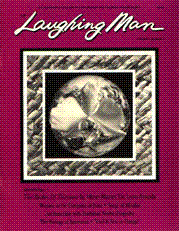
Speaking to devotees on December
16, 1975, Heart-Master Da Love-Ananda (Adi Da Samraj)
remarked, “There is only one process that makes a
difference, the process of distraction in God. That is what
the practice of Spiritual life is. It is the only thing
worth doing. Everything else is a hellish evolution of
desires and complications of form. there is only one way to
be saved, and that is to love God to the point of absolute
distraction.”
It was through their distracted
love for him that Krishna attracted the gopis beyond their
conventional destinies. The cowherd maidens were madly
attracted by the Radiance of the young Adept, and they
wandered after him, forgetting cattle and husbands. The same
paradigm of devotion, witnessed in the relationship between
an Adept and the female devotees surrounding him, appears
throughout the religious traditions. This devotional
relationship is exemplified in the ancient Vedic custom of
bramavivaha, in which young women dedicated themselves in
marriage to a God-Man as a Spiritual service performed for
the sake of enlightening others. In modern times, this
practice was revived by Sri Upasani Baba Maharaj of Sakuri
(1870-1941), who “married” over two dozen women who formed
the foundation of his ashram, the Kanya Kumari
Sthan.
Likewise, in the Company of
Heart-Master Da Love-Ananda there has generally been a small
group of women who have served his physical environment and
human form most personally. And, while the practice of all
devotees is based on the ecstatic relationship to the Adept,
these women have epitomized that devotional relationship to
him. Through his Spiritual service to these women,
Heart-Master Da has developed aspects of his Wisdom-Teaching
that serve everyone, men and women alike. Thus, their
particular relationship to the True Heart-Master not only
serves him personally, but also, by extension, all
devotees.
In the following article, Carolyn
Lee explores Jesus of Nazareth’s relationship to some of the
women “distracted” in love by this fiery Teacher and loving
Master who attracted people of many faiths beyond
themselves.
Elizabeth, Mother of John
the Baptist
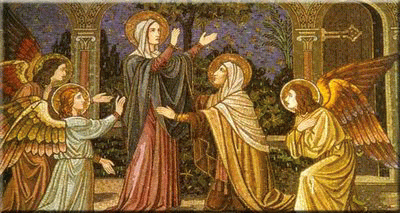
Beginning
our discussion chronologically, the first woman associated
with the life of Jesus was not his mother, Mary, but
Elizabeth, the mother of John the Baptist, who is described
as a kinswoman of Mary. The first chapter of Luke’s Gospel
recounts Elizabeth’s conception at an advanced age and her
gratitude to God that she would no longer be barren. The
event of her pregnancy is paired with the annunciation to
Mary and the two women come together to rejoice in the
Divine blessing they have mutually received. Elizabeth’s
unborn son, destined to be the forerunner of Jesus, is said
to leap in her womb, filling Elizabeth with the grace of
recognition of the one her cousin is to bear.
Christian art provides many tender
renditions of Elizabeth and Mary embracing, enveloped in the
mystery of their bodily intimacy with God. Like all the
infancy narratives in the Gospels, Elizabeth’s story points
to the significance of the birth of Jesus, rather than to
the facts of the event.
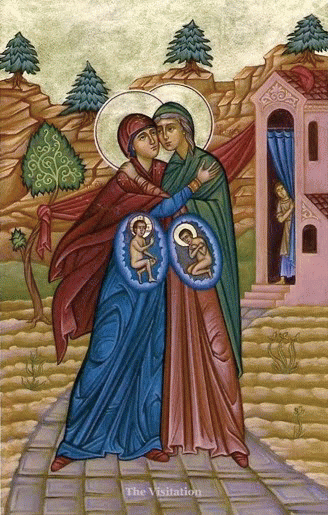
Mary, the Mother of
Jesus
As
a real historical figure, Mary is very difficult to reach.
Within a couple of crocuries of the life of Jesus she had
passed into myth as Theotokos, the God-bearer, and was
worshipped as Queen of Heaven. New Testament references to
her after the birth narratives are relatively few but
nonetheless striking for that. The first two references,
which precede the public ministry of Jesus, are probably
legendary, but they serve to indicate a sermon between Jesus
and his mother regarding his growing consciousness of a
special mission
In the first story, Jesus, at the
age of twelve, accompanies his family on a pilgrimage
Jerusalem at Passover time. Unbeknownst to his relatives,
Jesus stays behind, taking the opportunity to debate the
Hebrew Law with the leading rabbis at the temple. During
their homeward journey his parents notice his absence and
return to Jerusalem anxiously seeking him. When he is
discovered, his mother reproaches him for the distress he
has paused them. She receives the famous reply: “Why were
you looking for me? Did you not know that I must be busy
with my Father’s affairs?” Mary, we are told, did not
understand what he meant, but “she stored up all these
things in her heart”.
By the time Jesus reached adulthood
Mary must have been well aware of remarkable powers in her
son. The story of the wedding at Cana in Galilee, at which
Jesus and his mother are guests, may derive from a
combination of Old Testament material and Hellenistic
miracle tales about wine. In the Gospel account (John
2:1-10) Mary appeals to her son when wine runs out,
apparently in the hope that he will use his powers to save
their hosts embarrassment. Jesus replies, “Woman, why turn
to me? My hour has not come yet.” But in spite of this
rebuff to his mother, Jesus is said to have instructed the
servants to fill the water jars with water. When they draw
off the liquid they find it is wine. The dialogue with Mary
suggests that Jesus acts for his own mysterious reasons
rather then in direct response to his mother, who, perhaps,
liked to enjoy reflected glory from the prowess of her
son.
Apart from these stories of dubious
his historicity a much more stark encounter is described in
two Gospels (Mark 3:31-35 and Luke 8:19-21) which is
anything but flattering to Mary.
Modern commentators agree that it is
is not the sort of material likely to have been by the early
Church. Jesus is teaching one day when his mother and
brothers arrive to see him They are obliged to send a
message to him as they cannot reach him for the crowd. When
he receives the message, Jesus says to those sitting around
him, “Who are my mother and my brothers? Here are my mother
and my brothers … my mother and my brothers are those who
hear the word of God and put it into practice.” A similar
moment occurs when a woman in a crowd around Jesus cries
out, “Happy the womb that bore you and the breasts you
sucked!” (Luke 11:27-28). Jesus replies, “Still happier
those who hear the word of God and keep it!”
These incidents add up to a Divine
play between Jesus and his mother, the purpose of which is
to serve her Spiritual recognition of him. Contrary to the
weight of Christian tradition, the Gospels indicate that
Jesus did not regard as important the fact that Mary was his
natural mother. He was inviting her to pass through a
profound crisis that involved her surrender of the role of
mother to assume that of disciple. The Gospel of John
suggests that she did pass through this transformation.
Witherington (pp. 94-95) holds the view that the beloved
disciple saw Mary as a devotee, one whom Jesus himself had
acknowledged in the family of faith. Independent support for
this conclusion appears in the Acts of the Apostles (1:14),
where Mary is mentioned as a member of the devotional
community that gathered together after the Ascension of
Jesus to prepare for the promised baptism of the Holy
Spirit.
Mary’s path was perhaps uniquely
difficult. The other women who followed Jesus were not
impeded by a prior natural relationship; they had the
advantage of a spontaneous response to the shock of his
appearance in their lives.
The Woman at the
Well
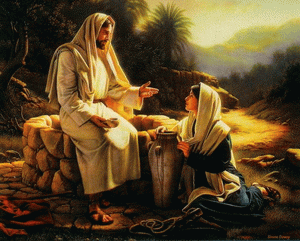
The
shock of sudden encounter with the Adept comes through in
the story of Jesus and the Samaritan woman at the well of
Sichar. The account occurs in John 4:5-26 and describes
Jesus, wearied by a long journey, sitting by the well while
his disciples go to the town to buy food. A woman comes to
draw water, and he asks her for a drink, much to the woman’s
astonishment, for “Jews … do not associate with
Samaritans”. The dialogue that follows is a play on the
exoteric and esoteric meanings of water. Jesus is using
water to expound his hidden teaching on the Spirit. John
4:10:
“If you only knew what God is
offering and who it is that is saying to you: Give me a
drink, you would have been the one to ask, and he would have
given you living water.”
“You have no bucket, sir,” she
answered, “and the well is deep: how could you get this
living water?” Jesus replied, “Whoever drinks this water
will get thirsty again; but anyone who drinks the water that
I shall give will never be thirsty again: the water that I
shall give will turn into a spring inside him, welling up to
eternal life.”
“Sir,” said the woman, “give me
some of that water, so that I may never get thirsty and
never have to come here again to draw
water.”1
1. This and all other
biblical quotations are taken from The Jerusalem Bible,
Reader’s Edition (Garden City, New York: Doubleday &
Co., 1968).
When Jesus shows that he knows the
character of her life (little better than a prostitute from
a Jewish point of view) the woman declares him to be a
prophet and questions him on the true place of worship, an
issue of difference between Jews and Samaritans. Jesus
responds that a revelation of the real nature of God and of
worship is now being made:
“God is spirit, and those who
worship must worship in spirit and truth.”
The woman said to him, ‘I know
that Messiah – that is, Christ – is coming; and when he
comes he will tell us everything.”
“I who am speaking to you,” said
Jesus, “I am he.”
The woman then left her water jar
and returned to the town, confessing her experience and
asking, “I wonder if he is the Christ?” The Gospel account
says that many Samaritans came to Jesus and invited him to
stay in their town, with the result that many more put their
faith in him and became disciples.
Many New Testament scholars have
pondered this story, in itself a beautiful and skillful
literary piece, trying to discover whether it is merely a
theological composition or whether it might have a basis in
fact. After weighing the evidence, Witherington (p. 58)
concludes that it is quite likely that a real encounter lies
behind it. It is consistent with the broad witness of the
Gospels, which show Jesus’ teaching making its point again
and again among the unsophisticated, the unimportant, the
sick, and the socially unacceptable. Jesus speaks of
prostitutes, tax collectors, and sinners entering the
kingdom of God ahead of the pharisees, the custodians of the
religious establishment (Matthew 21:31). He also speaks of
the secrets of the kingdom being hidden from the “learned
and the clever” and revealed to “mere children” (Luke
10:21). The Jewish women of Jesus’ day were children in this
sense. They were not instructed in the Law nor allowed to
become students of rabbis. Therefore it is nothing short of
iconoclastic that John’s Gospel should connect Jesus’ secret
Spirit-teaching with an unlettered and sinful woman who was
not even a Jew.
Women Healed by Jesus
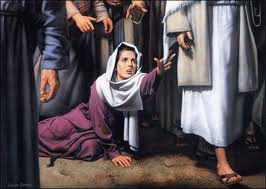
As
a healer, Jesus obviously responded to both men and women,
but Luke’s Gospel makes a specific connection between
healing and discipleship in the case of women. Luke 8: 1-3
reads
… he made his way through towns
and villages preaching, and proclaiming the Good News of the
kingdom of God. With him went the Twelve, as well as certain
women who had been cured of evil spirits and ailments: Mary
surnamed the Magdalene, from whom seven demons had gone out,
Joanna the wife of Herod’s steward Chuza, Susanna, and
several others who provided for them out of their own
resources.
A number of stories in the Gospels
describe Jesus healing women, although no descriptions
survive of the healing incidents in the cases mentioned
above. A particularly striking story is that of a woman with
a hemorrhage who makes her way to Jesus through a crowd
pressing around him. She reaches out and touches the hem of
his garment in the hope of receiving relief from her
twelve-year affliction (Matthew 9:20-22; Mark 5:25-34; Luke
8:43-48). She does not speak to Jesus but wishes to remain
unnoticed, presumably because of embarrassment and because
it was an offense for a woman in an unclean condition to
touch a rabbi – thereby rendering him also unclean,
according to the Law. Jesus heals her spontaneously and then
draws her out from the crowd, blessing her faith.
If Luke’s report is correct, there
were “many” such women who were moved, after receiving
healing, to abandon their ordinary responsibilities and the
protection of their homes to follow an itinerant teacher in
this way, thus exposing themselves to scandal and social
rejection. Nor were these women necessarily already outcasts
who had nothing further to lose. The mention of the wife of
Chuza, King Herod’s steward, and the remark that the women
offered material support in their ministry to Jesus shows
that ladies of substance and status also made the sacrifice
of discipleship. These women must have loved Jesus with a
love that moved them beyond every ordinary concern, leaving
them with no choice but to follow their hearts. This is not
to say that the men disciples who left fishing businesses
(Peter and Andrew, James and John) and a government job
(Matthew, the tax collector) were not also heart-smitten.
The particular role of healing in Jesus’ calling of women is
interesting, because it implies a transformation in the
body-mind as the basis of conversion of the heart. Feminine
wisdom and intuition are natively rooted in the body and its
feelings, the natural seat of a woman’s love-response and
recognition of the Divine. Thus, the traditions often show
female disciples of Spiritual Masters living their sadhana,
or Spiritual practice, in intimate bodily service to the
Adept.
The woman is already forgiven
because her heart is broken open. She is careless of
impropriety or loss of face because she is lost in love and
already enjoys the Divine embrace. The Pharisee, on the
other hand, is still closed to what Jesus has to
offer.
|
The story of Jesus healing
of Simon Peter’s mother-in-law is told in Mark
1:29-31:
On leaving the
synagogue, he went with James and John straight to
the house of Simon and Andrew. Now Simon’s
mother-in-law had gone to bed with fever, and they
told him about her straightway. He went to her,
took her by the hand and helped her up. And the
fever left her and the began to wait on
them.
A modern-day account of a
similar healing is related by one of the doctors
serving Heart-Master Da Love-Ananda and the
community in Hermitage in 1983:
One afternoon Heart-Master
Da left The Matrix, his isolated residence, and
traveled for 11 mysterious reasons” to the village
where devotees live. One of the women responsible
for serving Heart Master Da’s immediate
circumstance was staying in the village under the
supervision of one of the Hermitage doctors, who
intended to quarantine her at her quarters in the
village. She was suffering a 104 degree fever, was
possibly contagious, and needed rest. It had been
suggested she stay in the village, where she could
continue to be looked after by the doctors. But
there was an emotional aspect to her illness to
which we had not been sensitive. Because she had
been ill for several days, she was unable to
perform her services to the True Heart-Master – As
Heart Master Da later pointed out, her anxiety
about her service to him was a factor in her
symptoms, which seemed to be getting worse. On
occasions when she saw Heart-Master Da. however,
she would immediately feel better and her fever
would subside.
Concerned over the unusual
nature and duration of the symptoms, we called
local doctors to find out if the woman had
contracted a tropical disease unfamiliar to us.
When they confirmed no evidence of tropical
disease, Heart-Master l)a Suggested that she return
to The Matrix with him. On the trip Heart-Master Da
held her hand and talked to her about nature and
the sunset and the boat they could see in the
distance. Heart-Master flu made a point to hold her
hand for the twenty-minute ride. At The Matrix, a
health representative took her temperature and four
and there was no fever at all. The fever did not
return.
Heart-Master Da later
explained that on the ride across the island he
could feel the heat in her hand and that her
contact with him was sufficient for the fever and
other symptoms to be released. He commented that
the doctors did nut sufficiently acknowledge the
heating involved in her relationship with him and
his spontaneous play.
|
The Anointing
Stories
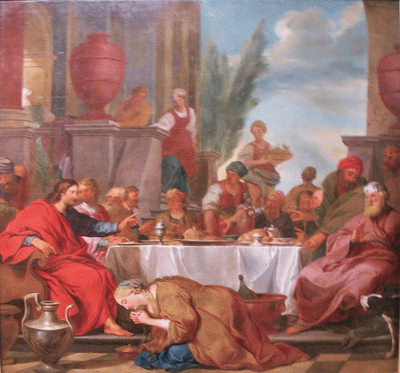
The
bodily dimension of worship and service comes
through strongly in several stories describing a
woman anointing Jesus with costly perfume as he
sits at a banquet. The accounts in Mark and John
are closely related and apparently describe the
same event. Luke’s narrative has distinctive
features suggesting that the anointing element has
been introduced into a different situation, either
deliberately by the Gospel writer, or as a result
of a mixing at the stage of oral transmission
(Witherington, p. 111).
In Mark’s account, an
unnamed woman pours a flask of ointment over the
head of Jesus, while in John’s story Mary of
Bethany kisses his feet and anoints them with
perfume, wiping them with her hair. The reaction of
the onlookers (Pharisees and male disciples) in
both accounts is one of embarrassment and righteous
indignation. Mark 14:4-6:
Some who were there said
to one another indignantly, “Why this waste of
ointment? Ointment like this could have been sold
for over three hundred denarii and the money given
to the poor”; and they were angry with her. But
Jesus said, “Leave her alone. Why are you upsetting
her? What she has done for me is one of the good
works. You have the poor with you always, and you
can be kind to them whenever you wish, but you will
not always have me. She has done what was in her
power to do: she has anointed my body beforehand
for its burial. I tell you solemnly, wherever
throughout all the world the Good News is
proclaimed, what she has done will be told also, in
remembrance of her.”
The formal anointing of
rabbis’ feet apparently occurred among the Jews,
and Greek men are known to have had their feet
smeared with ointment by a female slave
(Witherington, p. 113). It is the extravagance in
the quantity and quality of the ointment, “the
scent of which filled the whole house” (John 12:3),
and the engagement of the whole body in wiping
Jesus’ feet with her hair that made the woman’s
action scandalous. She was literally ecstatic,
outside or beyond her normal condition, transported
by love and devotion. Jesus, it seems, saw the
woman’s action not merely in personal, emotional
terms but as a sacramental service to his body.
Read from the point of view of some oriental
traditions, which emphasize Guru-devotion through
bodily worship of the feet or padukas (ceremonial
sandals) of the Spiritual Master, this story stands
as a paradigm of submission to and recognition of
the Divine in human form.
|
Some Christian interpretations of
the story also express this insight: ” … the mystery of
his incarnation may be understood by his feet in themselves:
the means by which the divine touched the earth by taking
flesh” (Homil. xxxiii, In Evangelio, Gregory the
Great, Migne, Patrologia Latin, vol. 76, col.
1242).
The anointing story in Luke presents
the woman as a well-known prostitute, weeping over the feet
of Jesus, wiping them with her hair, and then anointing
them. A conflation of stories and traditions does seem to be
present here. It may be that some woman, moved to conversion
by her attraction to Jesus, became a disciple and later
performed an anointing. Christian tradition from an early
date took the view that this prostitute who anointed Jesus
was to be identified with Mary Magdalene, his principal
female disciple, although there is no Gospel authority for
this (see below). The most interesting aspect of the story
as it occurs in Luke are Jesus’ remarks to his host, Simon
the Pharisee, who doubts that Jesus can be a prophet because
he has allowed the woman to touch him (Luke
7:44-48):
“Simon,” he said, “you see this
woman? I came into your house, and you poured no water over
my feet, but she has poured out her tears over my feet and
wiped them away with her hair. You gave me no kiss, but she
has been covering my feet with kisses ever since I came in.
You did not anoint my head with oil, but she has anointed my
feet with ointment. For this reason I tell you that her
sins, her many sins, must have been forgiven her, or she
would not have shown such great love. It is the man who is
forgiven little who shows little love.”
Martha and Mary of
Bethany
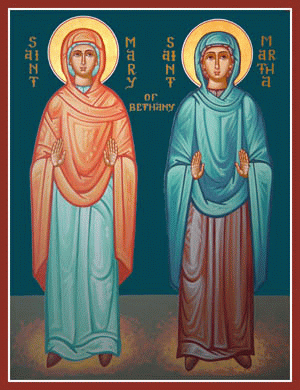
The
record of Jesus’ relationship with the two sisters of
Bethany provides a rare glimpse of Jesus in active
relationship to two of his women disciples. These women, it
would appear, did not travel with him but lived at home with
their brother Lazarus, offering hospitality to Jesus from
time to time. Martha was probably the elder, as Luke
describes her “receiving Jesus into her house”. In any case
the stories consistently show Martha to be the active
sister, taking charge and showing initiative. Mary’s
demeanor, on the other hand, is quiet and
contemplative.
The famous, even proverbial,
occasion mentioned by Luke has Jesus teaching in their house
with Mary sitting at his feet while Martha is “distracted
with all the serving”. Martha feels increasing anger that
her sister is not helping her and finally explodes, “Lord,
do you not care that my sister is leaving me to do the
serving all by myself? Please tell her to help me.” (Luke
10:40) Martha is undone by a few words from Jesus, who
dismisses her anxiety and agitation, indicating that Mary is
doing the only necessary thing, that is to say, submitting
all her attention to him. Luke 10:41-42:
“Martha, Martha,”he said, ‘you
worry and fret about so many things, and yet few are needed,
indeed only one. It is Mary who has chosen the better part;
it is not to be taken from her.”
The other story of the sisters
concerns the illness of their brother Lazarus and their
urgent message to Jesus to come and save his life. By the
time Jesus arrives, however, Lazarus is dead and buried.
According to the account Jesus raises him from the dead, but
it is John’s account of his play with the sisters prior to
this event that is most pertinent here. Jesus is testing
them. He delays coming. Martha goes out to meet him when he
is still some way from their village, blurting out her
grief, distress, and even anger that he did not come sooner.
In the exchange that follows Jesus probes her recognition of
him and Martha finally responds, “I believe that you are the
Christ, the Son of God, the One who was to come into this
world.” With Mary the encounter has a different quality.
When Jesus sends for her she collapses in grief at his feet,
and although her words are the same as Martha’s (“Lord, if
you had been here, my brother would not have died”),Jesus’
response is different. Mary’s heart-connection to him is
such that he weeps. Amid intense emotion he asks to be taken
to the tomb and that the tomb be unsealed. Martha provides
the entirely human and comic line, “Lord, by now he will
smell; this is the fourth day.”
Martha is amusing, and also
instructive, because she is so true to life. Her energy and
generosity are attractive. At the same time there is an
impulsiveness in her vitality, which tends to cloud a deeper
response, a response that certainly existed, since one of
the few confessions of the nature of Jesus recorded in the
Gospels is placed in her mouth. In the first story Jesus is
not criticizing Martha’s desire to serve, but rather the
agitation that is distracting her from the true significance
of the occasion and preventing her Spiritual alignment to
him. Mary’s virtue lies in that alignment. The message does
not seem to be that Martha should do exactly as Mary does
but that she should serve in the disposition of a devotee,
rather than as a harried hostess. A reference to Martha
serving at a banquet for Jesus and Lazarus after Lazarus is
restored to life (John 12:2) shows Martha still in her
serving role, but now, one imagines, with a new attitude,
the peace of gratitude and devotion. Witherington (p. 112)
points out that prosperous Jewish women of the time did not
serve their guests personally but were ‘expected to leave
that to the servants. This means that Martha was literally
assuming the role of servant as a way of expressing her love
for Jesus. She was fulfilling his repeated injunction that
his disciples must live as servants, following his own
example.
Perhaps the most original commentary
on Martha and Mary in the Christian tradition occurs in a
sermon by Meister Eckhart, the great Dominican mystic and
theologian (vernacular sermon eighty-six). Contrary to
tradition, which lauded Mary above Martha as the perfect
symbol of contemplation, Meister Eckhart praised Martha
enthusiastically for the fact that she embraced life
wholeheartedly while not lacking in devotion to Jesus: “What
a wondrous involvement both outwardly and inwardly:
understanding and being understood; seeing and being seen;
holding and being held” (The Women Around Jesus, p.
29).
Mary, on the other hand, he regarded
as one-sided, not yet mature. She has to learn to live and
assume life-responsibilities rather than merely to listen
passively. But whatever Mary may still have had to learn,
the Gospel stories show her living a life of steady heart
remembrance of Jesus, while Martha is at a different stage,
still phasing in and out of it.
The Women Who Went to the
Tomb
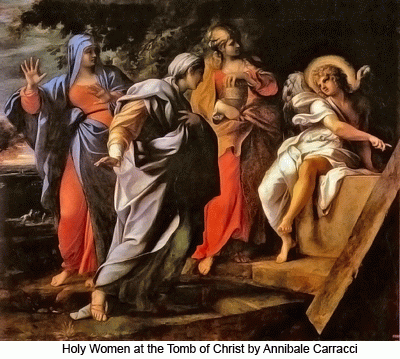
All
the Gospels associate female witnesses with the death of
Jesus. Luke 23:28 describes lamenting women along the via
crucis, the “daughters of Jerusalem” whom Jesus counseled to
weep not for him but for their own loss, the loss of the
Master. John’s Gospel (19:25-26) mentions women beside the
cross (Mary, his mother, his mother’s sister, and Mary
Magdalene), while the other records describe his women
disciples standing at a distance (Matthew 27:55; Mark
15:40-41). Following the crucifixion there are three
accounts of women at the burial in Joseph of Arimathea’s
tomb (Matthew 27:61; Mark 15:47; Luke 23:55). According to
Luke, they returned home afterward “and prepared spices and
ointments” (23:56). Then, after the Sabbath observance,
“early in the morning on the first day of the week”, all the
Gospels describe women visiting the tomb, and, except for
John, mention that they carried spices to anoint the
body.
The notable absence of the leading
men disciples during these events (except for St. John at
the crucifixion) is striking. In view of the fact that men
presumably wrote these records, it is safe to assume that
the men really were hanging back, shocked, stunned, and
afraid. As men, they had more to lose than the women in
being identified with the teacher executed as a criminal. It
is also true that the women had specific responsibility
toward the dead body of Jesus. It was women’s work to
prepare and anoint a corpse. While the Gospel accounts are
terse, later Christian literature and commentary often
imagines the women’s desolation in passionate and even
romantic terms. They came to incarnate the undying myth of
feminine grief at separation from the beloved, both human
and Divine. This is especially true in the case of Mary
Magdalene, to whom we will turn in a moment. What is
impressive about the largely anonymous group of women who
followed Jesus is their fidelity and endurance. Even after
the worst had happened, they were still with Jesus, still
serving his body.
Mary Magdalene
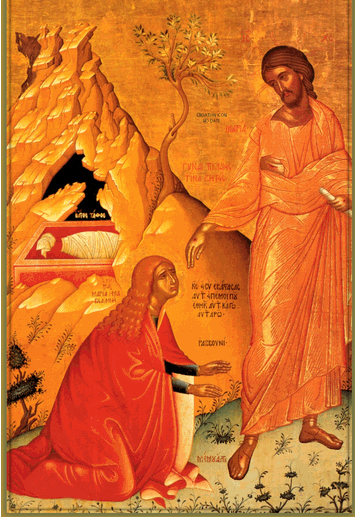
The Mary Magdalene of Christian
tradition is a largely invented character combining three
different persons. The only woman so named in the Gospels is
the Mary of Magdala (a town on Lake Gennesereth) from whom
Jesus cast out “seven demons” (Luke 8:2, see above), who
stood by the cross, and who met Jesus on Easter day beside
his empty tomb. The other female figures were absorbed under
her name through a quaint economy in the medieval
imagination. Thus, Mary of Bethany, because of her closeness
to Jesus, was considered to be the same person as Mary
Magdalene, and the anonymous prostitute who wept over the
feet of Jesus and anointed them (Luke 7:36-50) was held to
be Mary Magdalene as well because of the connection via Mary
of Bethany, who carries out an anointing in John
12:1-8.
Mary Magdalene’s relationship to
Jesus has been described in various ways, although it is
generally assumed that in actual expression it was wholly
platonic. Before considering other possibilities, it is
important to look at her principal (though perhaps
apocryphal) appearance in the New Testament, that is, her
experiences on Easter Day, which are described most fully in
John 20:1-18. The other women bearing ointments and spices
do not figure in John, which tells of Mary coming to die
tomb alone before dawn:
She saw that the stone had been
moved away from the tomb and came running to Simon Peter and
the other disciple, the one Jesus loved. “They have taken
the Lord out of the tomb,” she said, “and we don’t know
where they have put him.”
So Peter set out with the other
disciple to go to the tomb…. Simon Peter … went right
into the tomb…. Then the other disciple … also went in;
he saw and he believed…. The disciples then went home
again.
Meanwhile Mary stayed outside
near the tomb, weeping. Then, still weeping, she stooped to
look inside, and saw two angels in white sitting where the
body of Jesus had been…. They said, “Woman, why are you
weeping?” “They have taken my Lord away,” she replied, “and
I don’t know where they have put him.” As she said this she
turned around and saw Jesus standing there, though she did
not recognize him. Jesus said, “Woman, why are you weeping?
Who are you looking for?” Supposing him to be the gardener,
she said, “Sir, if you have taken him away, tell me where
you have put him, and I will go and remove him. “Jesus said,
“Mary!” She knew him then and said to him in Hebrew,
“Rabbuni!”which means Master. Jesus said to her, “Do not
cling to me, because I have not yet ascended to my Father
and your Father, to my God and your God.”So Mary of Magdala
went and told the disciples that she had seen the Lord and
that he had said these things to her.
Mary Magdalene behaves as a woman
widowed. Her Lord is her life. She has nothing left to do or
to defend. The men disciples come and go, but she remains
without human or heavenly consolation. As Gregory the Great
noted, there is a remarkable parallel between the story of
Mary’s seeking and finding the risen Jesus and the Shulamite
woman in the “Song of Songs” who has been separated from her
lover.
Another Patristic writer, Rabanus
Maurus (ninth century) likens her to the royal bride in
psalm 45 (46) and speculates that “Mary suffered as lovers
are accustomed to suffer” and “mourned inestimably
concerning the corporeal absence of her beloved lover”
(Migne, Patrologia Latina, vol. 171, cols. 1485-6). In the
Hindu tradition, the gopis of Sri Krishna are similarly
crazed in ardent search for their absent lover.
Like her Spiritual sisters of many
traditions, Mary Magdalene was enamored of the Divine in
human form to the point of distraction. There is a sense in
which all these feminine figures embody the Shakti force,
the attractive goddess power, such that they inevitably draw
their Lord back to them. And he comes, as it is said of the
bridegroom in the “Song of Songs” (4:9), “wounded by
love”.
But aside from the fascinating web
of romantic and erotic mythology that can be wound around
Mary Magdalene on the basis of John’s famous passage, if we
were to assume that she points to at least one real woman
who was the intimate friend and disciple of Jesus, what
might the nature of their relationship have been? The
question of a possible sexual relationship could not arise
in orthodox Christian tradition from the time of St. Paul.
Thus the passionate imagery that arose spontaneously in the
minds of many Christian writers was automatically given a
“spiritual” interpretation.
Possible exceptions are to be found
in Gnostic Christian writings of the second century that
were never accepted into the orthodox canon of the New
Testament. As these documents probably date from less than
one hundred years after the Gospel of John they deserve
serious attention. In the so-called “Gospel of Mary”, Mary
Magdalene’s senior position relative to the other women
disciples is noted. The apostle Peter says to her: “Sister,
we know that the Saviour loved you more than the rest of the
women … tell us the words of the Saviour which you
remember …” (John Dent, The Laughing Saviour, p. 127). In
the “Gospel of Philip” she is twice described as the
“consort” (koinonos) of Jesus.
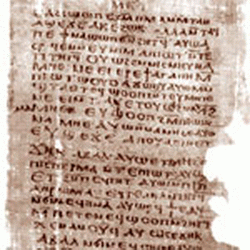 The The
Gnostic documents are mainly concerned with Mary as the
recipient of secret knowledge from Jesus and her prior place
as a Spiritual initiate in his community. Nevertheless, in
emphasizing her special relationship to him they support the
testimony of John’s Gospel.
Most Christian writers are unaware
of any tradition that could illumine how and why a Spiritual
Master might actually engage the sexual dimension.
Nevertheless there is a tradition, albeit an esoteric or
secret one, of Enlightened Teachers practicing a form of
tantric Yoga that involves sexual union with one or more of
their women devotees. An example is Padmasambhava, a
renowned Indian Buddhist Master who, with the aid of his
consort and principal disciple Yeshe Tsogyal, spread the
Dharma in Tibet in the eighth century. Some Adepts have
actually established a permanent circle of tantric consorts,
including Marpa the Translator and, in modern times, the
Indian teacher Upasani Baba. Many such figures have remained
celibate, depending on how they were spontaneously moved to
teach in any given time and place. The precise nature of the
relationship between Jesus and Mary Magdalene will never be
known, but the nub of it remains instructive-the necessary
transcendence (not the denial) of the body-mind in the true
relationship to an Adept. This is the crux of Jesus’ message
to Mary, which she is charged to carry to all his
disciples.
John’s account implies that at the
moment of recognition, Mary clasps the feet of Jesus or
reaches out to embrace him. His response, “Do not cling to
me”, shows that there is a lesson to be learned. Mary is
still relating to Jesus in a limited, human way, desiring to
keep and hold him on her own terms. As long as she persists
in this she obstructs both the fulfillment of his mission
and her own Spiritual growth. When he says, “I am ascending
to my Father and your Father, to my God, and your God”,
Jesus is calling her to release her passionate attachment to
his physical form and learn to relate to him as
Spirit.
Whatever the nature of Mary’s
awakening on that momentous day, she was facing profound and
unavoidable change. According to the Gospel accounts he was
gone from sight permanently within weeks of the first Easter
appearances. Elizabeth Moltmann speculates:
What does she have to say to us,
this woman who was healed, who combines friendship and
surrender, eros and agape? This woman who to the last clings
to this earth and relationships on it? This woman who learns
that resurrection means that she must not remain in this
circle, but learn to be open towards a new community? The
theology of Mary Magdalene has not yet been written. (The
Women Around Jesus, p. 75)
Conclusion
If women are to be found time and
again in special relationship to Spiritual Masters, the
reason lies in their capacity for profound recognition of
the Divine in human form. They, by nature, are more easily
able to live the submission that is the necessary ground of
Spiritual practice. Thus they become vital agencies for the
Divine work. In a memorable passage in the Sri mad
Bhagavatam, the sages who have failed to recognize Lord
Krishna make their confession:
We had heard it said everywhere
that the exalted Lord Vishnu, who is Himself all that
constitutes the Sacrifice-the time, the place, every one of
the materials used … was incarnate among the Yadus; and
yet, fools that we were, we did not know Him. But how blest
we are in our wives! It is their devotion that has led us to
firm faith in Hari
[Krishna].2
Sri Upasani Baba spoke of the native
Spiritual disposition of women as “daan”, or the giving of
oneself as a gift to God, and he described his circle of
women as “kanya kumaris” or “those who destroy illusion and
lead others to the Supreme Reality”. He claimed that women
could function as “Spiritual engines” capable of extending
the reach of his Spiritual influence.
While Heart-Master Da Love-Ananda
does not limit this quality to women, he has likewise spoken
of the female nature in relation to Spiritual life. He has
explained that “The male and female both need to awaken to
the feminine action, which is self-transcendence, and
fulfill it. In that case, both will also come into union
with the male role or action (the creative spirit or subtle
intelligence and generative power). Both need to restore the
balance of the halves or motives of the whole bodily
being.”3
Although little is known about the
women disciples of Jesus, what the New Testament does record
points to a profound hidden devotion and service in them, an
instinctive recognition of who he was. Represented by Mary
Magdalene, they were the soil in which Jesus could plant the
seed of true Guru devotion for the sake of his whole
community. In John’s account his final instruction to Mary
Magdalene is “Go and find my brothers and tell them
….”
2. N. Raghunathan, trans.,
Srimad Bhagavatam (Madras and Bangalore, India: Vigneswara,
1976).
3. Da Free John
(Heart-Master Da Love-Ananda), Love of the Two-Armed Form
(Clearlake, Calif.: The Dawn Horse Press, 1985), p. 177.
Carolyn Lee has been a student of
the Way of the Heart since November 1985. She has a PhD. in
musicology and until recently lectured in University
College, Cork, Ireland, specializing in medieval music and
liturgy. She writes:
I had my first encounter with
Heart-Master Da Love-Ananda’s physical presence at Maria
Hoop. Holland, in 1986. That unforgettable sighting of his
human form showed me the truth of my hear: both the strength
of my intuition of the Divine and my lifelong refusal of
love.
It was a warm summer day and
flies were buzzing around in the large hall where we sat. At
some point a woman attendant rose from her seat and knelt by
Heart-Master Da’s chair. She remained in an upright kneeling
position for the entire time, brushing away any flies that
came near. Her body was wholly turned to the need of
Heart-Master Da Love-Ananda, and her gaze remained with him
in unmoving devotion and love. I saw then what it is to be a
devotee, submitted, given in body and soul to the Divine. I
saw that this most graceful image of a woman at the feet of
the True Heart-Master has the power to draw all men and
women into the Fire of the Great One. That Fire even seemed
visible to me as the two motionless forms dissolved in
Radiance for a time.
Since this experience I have been
inspired to search the traditions to discover the women,
often hidden or in the background, who were intimate
devotees of living Spiritual Masters. Coming as I do from
the Christian tradition, it was natural for me to turn back
to the descriptions and stories of the women who knew Jesus,
to consider the gospel records about them, allowing what I
had seen and felt in the company of Heart Master Da to draw
me into the Spiritual heart of these records, however meager
and limited they may appear to be from an historical point
of view.
Selected Bibliography
Raymond E. Brown, The Gospel of St.
John and the Johannine Epistles, 3d ed. (Collegeville,
Minn.:The Liturgical Press, 1982)
Raymond E. Brown, The Community of
the Beloved Disciple (London: Paulist Press,
1979)
Raymond E. Brown, Mary in the New
Testament (Philadelphia: Paulist Press, 1978)
John Dent, The Laughing Saviour (San
Francisco: Harper & Row, 1976)
Keith Dowman, Sky Dancer: The Secret
Life of the Lady Yeshe Tsogyal (London: Routledge and Kegan
Paul, 1984)
Meister Eckhart, Sermons and
Treatises, vol. 11, trans. and ed Michael Walshe (London:
Watkins, 1981)
Helen Garth, Saint Mary Magdalene in
Medieval Literature (Johns Hopkins University Studies in
Historical and Political Science, Series xlvii, no. 3, Johns
Hopkins University Press)
Elizabeth Moltmann, The Women Around
Jesus (London; SCM Press, 1982)
Elaine Pagels, The Gnostic Gospels
(London: Penguin Books, 1980)
William Phipps, Was Jesus Married?
(New York: Harper Row, 1970)
Pierre, Cardinal de Berulle, Les
Oeuvres, 2 vols. (Paris, 1644,. Fats. Reprod. Maison
d’Institution de l’Oratoire Villa Bethanie, Montsoult, “De
la Magdaleine”, pp. 553ff.
Hanumanprasad Poddar, Gopi’s Love
for Sri Krishna (Clearlake, Calif.: The Dawn Horse Press,
1980)
The Talks of Sadguru Upasani Baba
Maharaj (Sakori, India: Upasani Sthan, 1976)
R. Wilson, The Gospel of Philip
(London, 1962)
Ben Witherington III, Women in the
Ministry of Jesus (Cambridge: Cambridge University Press,
1984)
The Jerusalem Bible (London: Darton,
Longman, and Todd 1966)
Srimad Bhagavatam, trans. N.
Raghunathan (MadrasBangalore: Nighneswara Publishing House,
1976)
|










 The
The